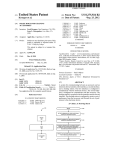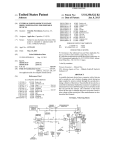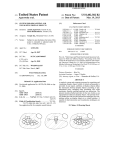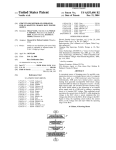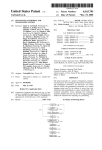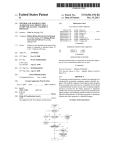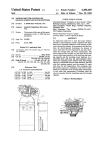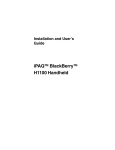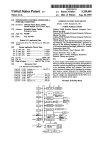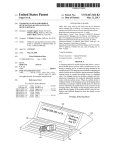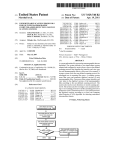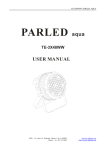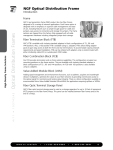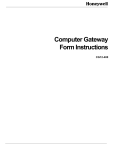Download VBUS CHARGE @D
Transcript
US008541983B2 (12) United States Patent Veselic et al. (54) CIRCUIT AND METHOD OF OPERATION FOR AN ELECTRICAL POWER SUPPLY US 8,541,983 B2 (10) Patent N0.: (45) Date of Patent: (56) Sep. 24, 2013 References Cited U.S. PATENT DOCUMENTS (75) Inventors: Dusan Veselic, Oakville (CA); Martin 3,775,659 A George Albert Guthrie, Moffat (CA) Notice: Subject to any disclaimer, the term of this patent is extended or adjusted under 35 2/1984 Banks et al. (Continued) (73) Assignee: BlackBerry Limited, Waterloo, Ontario (CA) (*) ll/l973 Carlsen, II 4,433,251 A FOREIGN PATENT DOCUMENTS DE 201 16 332 WO PCT/CA2004/000249 1/2002 9/2004 OTHER PUBLICATIONS U.S.C. 154(b) by 271 days. “Notice Requesting Submission of Opinion,” issued in correspond ing Korean Patent Application No. 10-2005-7015376, dated Oct. 27, (21) App1.No.: 13/175,541 2010, pp. 1-6. (22) Filed: Charging Big Supercaps, Portable Design, p. 26, Mar. 1997. Jul. 1, 2011 (65) US 2011/0260680 A1 Oct. 27, 2011 Related U.S. Application Data (63) Continuation of application No. 13/028,361, ?led on Feb. 16, 2011, now Pat. No. 7,999,514, which is a continuation of application No. 12/860,591, ?led on Aug. 20, 2010, now Pat. No. 7,906,940, which is a continuation of application No. 10/372,180, ?led on Feb. 21, 2003, now Pat. No. 7,791,319. (51) Int. Cl. H02] 7/00 H02] 7/16 G01R 19/12 (52) (2006.01) (2006.01) (2006.01) Primary Examiner * Edward Tso Assistant Examiner * Alexis Boateng (74) Attorney, Agent, or Firm * Finnegan, Henderson, Farabow, Garrett & Dunner, LLP (57) ABSTRACT A battery charging circuit comprising: a semiconductor switch having an output connected to a rechargeable battery; a battery charge controller for receiving power from an exter nal source, and supplying output power to a portable device and the input of the semiconductor switch, the current output of the battery charge controller being controllable; and a voltage sensing circuit for: measuring the voltage drop across the battery charge controller; and responding to the voltage drop across the battery charge controller by modulating the U.S. Cl. semiconductor switch to reduce the quantity of current sup USPC ......... .. 320/134; 320/156; 320/132; 320/159; plied to the rechargeable battery when the voltage drop is too great; whereby the total power dissipated by the battery charge controller is controlled, the portable device receiving the power it needs to operate and the rechargeable battery 320/160; 320/114; 307/32; 307/152 (58) (Continued) Prior Publication Data Field of Classi?cation Search USPC ............... .. 320/112,113,114,115,152,157, 320/155,134,132,156,165,158,159,160; 307/32, 34, 38, 39, 152, 159 See application ?le for complete search history. receiving any additional available power. 26 Claims, 8 Drawing Sheets 30 / VOLTAGE SENSING CIRCUIT VBUS BATTERY CHARGE CONTROLLER GATE @DOUT IN / 20 R1 PORTABLE DEVICE :-\24 US 8,541,983 B2 Page 2 References Cited 4,510,431 4,755,816 5,173,855 5,179,335 5,229,649 5,272,475 5,444,378 U'S' PATENT DOCUMENTS A 4/1985 Winkler A 7/1988 DeLuca A 12/1992 Nielsen et al. A 1/1993 Nor A A 7/1993 Nielsen et al. 12/1993 Eaton et al. 8/1995 Rogers A 6,191,552 B1 * 6,211,649 6,252,375 6,300,744 6,346,794 6,362,610 6,373,229 6,437,541 6,437,543 6,498,458 6,801,967 B1 B1 B1 B1 B1 B1 B1 B1 B1 B2 6,936,936 B2* 2/2001 4/2001 6/2001 10/2001 2/2002 3/2002 4/2002 8/2002 8/2002 12/2002 10/2004 K3168 61211. ................. .. 320/112 Matsuda Richter et a1. Shum Odaohhara Yang Slusky Sakurai Oler et a1. Chen Nakamura etal. 5,631,503 A 5/1997 Ciof? 5,638,540 A 6/1997 Aldous 2001/0004310 A1 6/2001 Kono 5,651,057 A 5,721,481 A 7/1997 Blood et al. 2/1998 Narita et al. 2001/0015635 A1* 2002/0079866 A1* 8/2001 Leppo et a1. ................ .. 320/116 6/2002 Odaohhara ................. .. 320/150 5,734,254 A 5,769,877 A 3/1998 Stephens 6/1998 BaffefaS,Sf~ 2003/0052547 A1 2003/0076138 A1 3/2003 Fischer et a1. 4/2003 Hwang 5,804,894 A 9/1998 Leeson et al. 2003/0146736 A1* 8/2003 5,814,972 A 5,850,113 A 9/1998 Shimada et al. 12/1998 Weimer et al. 2003/0155892 A1 2003/0204708 A1 8/2005 Fischer et a1. .............. .. 307/151 Kosuda et al. .............. .. 320/132 8/2003 Poletti 10/2003 Hulme et al. 5,898,290 A * 4/1999 Beard et a1. ................. .. 307/150 2004/0042138 A1 3/2004 Saito etal. 5,898,293 A * 4/1999 2004/0100226 A1* 5/2004 Sakurai ....................... .. 320/136 5,926,006 5,939,860 6,100,664 6,104,162 6,104,759 6,118,254 6,130,518 A A A A A A A 7/1999 8/ 1999 8/2000 8/2()()() 8/2000 90000 10/2000 * Tamaiet al. ................ .. 320/136 Burroughs et al. William Oglesbee et a1. Sajnsbmy et 31, C?fknef et al~ Faulk Gabehart et a1. ' OTHER PUBLICATIONS Examiner’s report on European Patent Application No. 047129796 mailed Dec. 15, 2010, from the EPO (4 pgs.). Supercapacitor: User’s Manual, vol. 2 (Japan, Tokin Corp., date unknown) . 231233552; 2 @5888 etal' """"""""" " 320/132 6,157,173 A * 12/2000 Bamnowski et al‘ ““““ H 320/152 6,172,478 B1 1/2001 Leppo et a1. 6,184,652 B1 2/2001 Yang China Of?ce Action issued Nov. 17, 2011, in Application No. 2004800047271 and Engllsh Translat1on (4 pages). * cited by examiner US. Patent Sep. 24, 2013 US 8,541,983 B2 Sheet 1 0f 8 18 / PORTABLE DEVKJE PC 14. BATTERY CHARGE USB CARD CONYROLLER \ / 12 FIG- 2 (Pn'or Art) 20 US. Patent Sep. 24, 2013 US 8,541,983 B2 Sheet 2 0f 8 18 FIG. 3 / PORTABLE DEVICE PC 11 BATTERY USB CARD CHARGE CONTROLLER \ 20 FIG. 4 30 VOLTAGE sewsme cchun BATTERY VBus CHARGE CONTROLLER GATE @D OUT |N / 20 PORTABLE R1 DEVICE \ 18 - US. Patent Sep.24,2013 US 8,541,983 B2 Sheet30f8 mo<IwE > m2; .mvam US. Patent Sep.24,2013 US 8,541,983 B2 Sheet40f8 41 qw/Wv 8 N@ mamA A 5 W"?Sam+y; w.UE H/3E3wc?éoasnz“$w5sm2ét8o J_ 6 § 2 8w3m> mm F M [email protected] 8 5 US. Patent Sep. 24, 2013 US 8,541,983 B2 Sheet 5 0f 8 $1250 OE4h> 26 "a 5 zF E QUE < LI“ 0mzw;N 52"w 25m ms“.,w0. l.“ “We M me6w?5:2%sz020NF M£88 D .m minmy? H . 96Q626as965 “32w XqI N"t:wxgmmNEE__k?w H vv m ? P FVL l_. mg3 % W 38522V5%8M 2 8>Emma96w $02EI x?2:.§v52oz9v626.2 EHESu]g m2250>25<35m$5 _m M i Q. w LAIT H 02026‘ ‘ .52<<<_.<|m> VJ;- oz50% 52%v ea26 5-26 US. Patent Sep. 24, 2013 Sheet 8 0f8 90 '\ CONNECTING BATTERY CHARGE CONTROLLER TO EXTERNAL POWER SUPPLY 92 CONNECTING OUTPUT OF BATTERY CHARGE T \ CONTROLLER TO PORTABLE DEVICE AND A SEMICONDUCTOR IN PARALLEL I 94\ CONNECTING OUTPUT OF SEMICONDUCTOR TO RECHARGEABLE BATTERY I 96 \ CONTROLLING CURRENT OUTPUT LEVEL OF BATTERY CHARGE CONTROLLER I 98 / MEASURING VOLTAGE DROP ACROSS BATTERY CHARGE CONTROLLER I 100/ RESPONDING TO VOLTAGE DROP ACROSS BATTERY CHARGE CONTROLLER BY MODULATING SEMICONDUCTOR SWITCH TO REDUCE CURRENT TO RECHARGEABLE BATTERY WHEN VOLTAGE DROP IS TOO GREAT FIG. 8 US 8,541,983 B2 US 8,541,983 B2 1 2 Hence, lithium batteries are almost invariably used with CIRCUIT AND METHOD OF OPERATION FOR AN ELECTRICAL POWER SUPPLY battery charge controllers designed to their particular charg ing parameters. application Ser. No. 12/860,591, ?led Aug. 20, 2010, (now Unfortunately, mo st battery charge controllers are designed to draw from a high capacity power supply with a steady voltage that will not sag appreciably under its current U.S. Pat. No. 7,906,940), which is a continuation of Us. demands. This is a problem when one attempts to use a power This is a continuation of Us. application Ser. No. 13/028, 361, ?led Feb. 16, 2011, which is a continuation of Us. application Ser. No. 10/372,180, ?led Feb. 21, 2003, (now supply with limited capacity. Some computer data buses such U.S. Pat. No. 7,791,319), all ofwhich are incorporated herein as USB (universal serial bus) buses can be used to provide power to external devices, but while such power supplies are by reference. This invention relates in general to battery chargers, and more speci?cally to a method and apparatus for charging a very convenient, they have limited capacity. The majority of personal computers (PCs) and laptop com battery in a portable communication device from a variety of puters available today, are provided with one or more USB power sources, including limited capacity sources such as an integral power node of a computer data bus. One such com ports as standard components. USB ports are designed to puter data bus would be a USB (universal serial bus) port. megabits per second, support PnP (Plug and Play) installation support data communication at speeds of 12 megabits and 1.5 software, and support hot plugging (i.e. devices can be con nected and disconnected while the PC is running). Thus, USB BACKGROUND OF THE INVENTION 20 With the current computing and information revolution, portable electronic devices such as cellular telephones, per ports are often used as interfaces to connect keyboards, mouses, game controllers, printers and scanners to PCs. As well, USB ports are operable to supply limited power to sonal digital assistants (PDAs), digital pagers and wireless connected external devices. The standard USB speci?cation email devices, are becoming very common. These portable requires that “high-power” USB ports be operable to provide devices are typically powered by internal batteries which must be recharged periodically by an external power source, 25 using a battery charger. Battery chargers generally receive cation for “low-power” USB ports requires a supply voltage power from a standard AC electrical outlet and convert the AC of 4.40-5.25 VDC and current of 100 mA (referred to as “one power into a low DC voltage for recharging a battery. The battery chargers of these portable devices also gener ally employ a “battery charge controller” to manage the 30 unit”). USB ports would seem to be a very logical choice as a power supply for portable devices for a number of reasons. To charging of the battery. Such battery charge controllers offer being with, USB ports supply a low DC voltage supply which is often very close to, or just above, the voltage of the battery functionality such as: regulating the voltage and current levels to the recharge able battery; a supply voltage of 4.75-5.25 VDC and a supply current of at least 500 mA (often referred to as “?ve units”). The speci? 35 being charged (many portable devices having battery voltages fully charged, be charged and re-charged many times, and be in the range of 2.5-4.5 VDC). As well, many portable devices may be operable to upload and download data or software, to and from a personal computer or a laptop computer (often referred to as “syncing”). Thus, many portable devices are supplied with docking cradles as shown in the system dia gram of FIG. 1. This is quite a straightforward system, as the docking cradle 10 is connected to a USB port 12 of a personal computer (PC) 14, via a simple USB cable and connectors 16. The portable device 18 need only be set down in the docking cradle 10 and an electronic connection to the PC 14, is made. If the USB port 12 has suf?cient power, it makes much safely operated. This charging algorithm generally proceeds more sense to use the USB port 12 to supply charging power as follows: to the portable device 18, rather than using a separate AC providing status signals to the main processor of the por table device, or operating one or more status LEDs (light emitting diodes): providing protection circuits such as overcurrent, under voltage, reverse polarity and overtemperature protec 40 tion; and shutting themselves off when the charging source has been removed, to minimize battery drain. Lithium ion battery packs, for example, must be charged according to a relatively strict algorithm so that they can be 45 charger. For example: 1. at the ?rst stage, any severe undervoltage or deep dis charge conditions are addressed. During this pre-charg ing stage, the battery voltage is gently brought up from a 50 1. a USB power supply will have less electrical noise than an AC charger, unless the AC charger incorporates large DC capacitors or inductors; very low or dead state, usually at a rate of 1/10 of the regular charge current; 2. an AC charger requires either a heavy transformer or an level (say, 4.2 VDC). At this point the battery will only expensive switching power supply, neither of which would be required if USB power is used; 3. in the USB power supply implementation, the cable and be at 40 to 70% of full capacity; and then 3. charging of the battery continues at a constant voltage connectors 16 used to connect the docking cradle 10 to the PC 14 could be used to carry both power and data, so no 2. next, the battery is charged at a constant current level, until the voltage across the battery reaches its design level (again, say 4.2 VDC) until it is fully charged. In this mode, the current drawn by the battery will drop over time. When the charge current has dropped to 10% of the 55 60 initial charge rate, or some other limit determined by the 4. there are no universal standards for AC power supplies; a battery manufacturer, charging is stopped. Charging must stop at this point because trickle charging is not acceptable for lithium batteries; an overcharge will dam age the cells, possibly plating out lithium metal and becoming hazardous. extra physical components would be required at all. In contrast, anAC power supply would have to be provided as a separate physical component from a USB data cable; and 65 given AC power supply may require 120VAC or 240VAC as an input, and may provide 3, 4.5, 6, 7.5 or 9 VDC out, with one of large number of different possible connectors and polarities. A traveller who forgets his AC power supply at home, may not be able to ?nd a suitable replacement. US 8,541,983 B2 3 4 In contrast, the USB standard is widely accepted, so that a traveller whose mobile device is equipped with a USB con nector will have a much greater chance of ?nding a charging There is therefore a need for a method and apparatus which allows standard computer data busses such as USB ports to simultaneously power portable devices 18 and their associ ated battery charge circuits 20 without having to design new source. Thus, it would clearly be desirable to use USB power to battery charge controllers with very speci?c applications. charge portable devices. Unfortunately though, as noted above, USB ports can only provide limited power. The prob This design must be provided with consideration for the tight lem becomes clear when considering the block diagram of FIG. 2. In this scenario, the portable device 18 and the battery physical board area inportable devices, and the reliability and operating parameters of battery charging circuits, the limited complexity of the design. charge controller 20 are connected to the USB port 12 in parallel, as under charging conditions the control switch 22 will be toggled so that the portable device 18 draws power from the USB port 12. When the battery 24 has become fully SUMMARY OF THE INVENTION It is therefore an object of the invention to provide a novel method and apparatus which allows standard battery charge controllers to be supplied from standard computer data ports charged by the battery charge controller 20 and the USB port 12 power removed, the control switch 22 is then toggled so that the portable device 18 draws power from the battery 24. This type of circuit may work in some circumstances, but it is not acceptable where the power source has limited capacity. If one attempts to power the portable device 18 and battery charge controller 20 simultaneously from the USB card 12, it is quite likely that too great a load would be placed on the USB card 12. The excessive load on the USB card 12 may result in an undervoltage or low current condition that could result in a number of undesirable problems such as: the bat and other power sources, which obviates or mitigates at least one of the disadvantages of the prior art. One aspect of the invention is broadly de?ned as a battery charging circuit comprising: a semiconductor switch having 20 an output connected to a rechargeable battery; a battery charge controller for receiving power from an external source, and supplying output power to a portable device and the input of the semiconductor switch, the current output of 25 tery 24 not becoming properly charged or becoming perma nently damaged, or the portable device 18 operating errati cally or becoming damaged. the battery charge controller being controllable; and a voltage sensing circuit for: measuring the voltage drop across the battery charge controller; and responding to the voltage drop across the battery charge controller by modulating the semi conductor switch to reduce the quantity of current supplied to by the battery charge controller 20. While such a design would reduce the total power drawn by the portable device 18 the rechargeable battery when the voltage drop is too great; whereby the total power dissipated by the battery charge controller is controlled, the portable device receiving the power it needs to operate and the rechargeable battery receiv and battery 24 in combination, there are a number of other ing any additional available power. As an alternative, the battery 24 and portable device 18 could be arranged as shown in FIG. 3 so that they are both fed 30 problems: 1. most importantly, there is still no control over the total Another aspect of the invention is de?ned as a battery 35 charging circuit comprising: a battery charge controller con nected to the external power supply and electrifying a battery and a portable device, and having a maximum current setting; and a regulating circuit for sensing the voltage drop across the battery charge controller, and modulating the current to the 40 battery to keep the power dissipated by the battery charge power that is drawn from the USB port 12; 2. the power drawn by the portable device 18 could disturb the carefully designed protection and charging mechanisms of the battery charge controller 26; 3. the portable device 18 and battery 24 compete arbitrarily for the available power, so they may adversely affect the operation of one another. If the available voltage drops too low, or insuf?cient current is available, either device may controller below a predetermined level. An additional aspect of the invention is de?ned as a method for charging a battery of a portable device via an external power supply, the method comprising the steps of: connecting operate erratically, or fail all together; 4. if the battery 24 is in a deep-discharge state when power is turned on, the voltage to the portable device 18 will be 45 supply; connecting the output of the battery charge controller, dragged down to the level of the deep-discharged battery. Typically, portable devices 18 will not be operable at such a low voltage level; and 5. the current that must be supplied to the battery 24 and the in parallel, to the portable device and the input of a semicon ductor switch; connecting the output of the semiconductor switch to the battery; controlling the current output of the 50 portable device 18 must be dissipated by the battery charge controller 20 or an external semiconductor in some way. The more power that is dissipated, the larger the battery charge controller 20 (or the external semiconductor driven by the battery charge controller 20) must be. Generally, a semiconductor’s ability to dissipate power varies with its surface area, thus, if the power dissipation is doubled, the semiconductor must increase by four times the surface 55 plied to the rechargeable battery when the voltage drop is too great; whereby the total power dissipated by the battery charge controller is controlled, the portable device receiving the power it needs to operate and the rechargeable battery receiving any additional available power. A further aspect of the invention is de?ned as a power 60 oped which are designed to operate with a USB power supply and a portable device 18, but that would be an expensive and supply circuit comprising: means for measuring the voltage drop across a battery charge controller providing power to a portable device and the input of a semiconductor switch in parallel; means for controlling the current output of the bat tery charge controller; and means for responding to the volt complicated solution. Each battery charge controller would have to be designed to suit a particular pairing of a portable device 18 and battery 24 because it would have to take the battery charge controller; measuring the voltage drop across the battery charge controller; and responding to the voltage drop across the battery charge controller by modulating the semiconductor switch to reduce the quantity of current sup area. New, dedicated battery charge controllers could be devel the input of a battery charge controller to the external power 65 age drop across the battery charge controller by modulating power consumption requirements of both components into the semiconductor switch to reduce the quantity of current account. supplied to the rechargeable battery when the voltage drop is US 8,541,983 B2 5 6 too great; whereby the total power dissipated by the battery charge controller is controlled, the portable device receiving voltage at the input and output of the battery charge controller the power it needs to operate and the rechargeable battery receiving any additional available power. could be taken from the output of the battery charge controller 20, while the other could be some reference voltage VREF; 20, as shown in FIG. 4. Alternatively, one input to the op amp either emulating the VBUS input to the battery charge control BRIEF DESCRIPTION OF THE DRAWINGS ler 20, or being scaled in some manner. Thus, by monitoring the voltage drop across the battery These and other features of the invention will become more charge controller 20 and knowing the maximum current that it may provide, the total power is known. Using this informa tion to modulate the power to the battery 24, the total power dissipated by the battery charge controller 20 may be con trolled. Also, because this circuit modulates the power available to the battery 24, this circuit can be designed to ensure that the portable device 18 receives the power it requires for opera apparent from the following description in which reference is made to the appended drawings in which: FIG. 1 presents a physical layout of a personal computer connected to a portable electronic device in a manner known in the art; FIG. 2 presents an electrical block diagram of a battery charging circuit and portable device being powered in paral lel; tion, while the rechargeable battery 24 only receives power when surplus capacity is available. FIG. 3 presents an electrical block diagram of a battery and portable device both being powered by a battery charge con troller; FIG. 4 presents an electrical schematic diagram of a battery charging circuit in a broad embodiment of the invention; 20 port 12, and within the range of power that the battery charge controller 20 is able to dissipate. This allows battery charge FIG. 5 presents a timing diagram of voltage, current and power curves for the charging of a lithium ion battery in an embodiment of the invention; FIG. 6 presents an electrical schematic diagram of a battery 25 charging circuit in a simple embodiment of the invention; FIGS. 7A, 7B and 7C present an electrical schematic dia gram of a battery charging circuit in a comprehensive embodiment of the invention; FIG. 8 presents a ?ow chart of a method of operating a 30 battery charging circuit in an embodiment of the invention. DESCRIPTION OF THE INVENTION As explained above, there is currently no effective design 35 which is capable of powering both a portable device 18 and a rechargeable battery 24 from a power supply with limited capacity. controllers 20 to be used “off the shelf ’, rather than having to design new and larger battery charge controllers 20 which can dissipate enough power to supply both the portable device 18 and battery 24. It also allows the battery charge controller 20 or external driving element to be kept physically small. With this power modulation mechanism, there is no longer power competition between the portable device 18 and the battery 24. The battery 24 receives power only if there is more power available than the portable device 18 requires. This may seem inconsistent with the charging requirements of batteries such as lithium cells, but the parameters of the circuit may easily be designed to accommodate them. As noted above, battery charge controllers are usually designed to suit a particular battery or family of batteries. For example, lithium batteries are charged in three phases: 1. resolving deep discharge conditions; 2. constant current charging until the battery reaches a certain A circuit which overcomes a number of the problems in the art, is presented as a block diagram in FIG. 4. This ?gure presents a battery charging circuit build around a standard battery charge controller 20. In this embodiment of the inven tion, the battery charge controller 20 receives power from an external source (VBUS) and feeds a portable device 18 and rechargeable battery or batteries 24 in parallel, but the feed to the battery 24 is made via a semiconductor switch Q1. Con trol of the current ?ow through the semiconductor switch Q1 is modulated by a voltage sensing circuit 30 which measures The total power consumed may therefore be modulated to stay within the limits of the power available from the USB 40 voltage level; and then 3. constant voltage charging until the charging current drops to a certain point. During the initial handling of deep discharge conditions, 45 comparatively little current is provided to the battery (typi cally 1/10 of the charge current). The circuit of the invention is therefore designed so that the battery will rarely be denied this very modest power demand. The constant current charging phase draws the greatest the voltage drop across the battery charge controller 20 and amount of power, but lithium cells do not suffer if the charg Q1 to the battery 24 when the voltage drop is too great. ing current is modulated or cycled during this phase. Thus, it is this phase that is altered the greatest by the circuit of the The voltage sensing circuit 30 allows the total power con sumption of the circuit to be inferred because the current this phase, the only negative impact will be that the charging reduces the current ?ow through the semiconductor switch output of the battery charge controller 20 is controllable, and power is the product of voltage drop and current. Most battery 50 invention. If the portable device 18 is used a great deal during 55 current is less than that of the constant current phase and charge controllers 20 known in the art are provided with some sort of maximum current control. In the exemplary embodi ments described hereinafter, for example, the maximum cur rent output of battery charge controller 20 is simply set via an external resistor R1, though of course, the current output could also be controlled in many other ways (for example, being programmable, application speci?c, or set via some drops continuously as the battery 24 becomes fully charged. More important, the battery 24 voltage stays at a constant, and maximum, level during this phase, so the total power dissi 60 form of analogue or digital input signal). Also in the embodiments described hereinafter, the voltage sensing circuit 30 itself is provided via an operational ampli ?er (op amp). Thus, the voltage drop across the battery charge controller 20 could simply be measured by comparing the of the battery 24 takes much longer. During the constant voltage charging phase, the maximum 65 pated by the battery charge controller 20 will be lower during the constant voltage phase, than it was during the constant current phase. As will be described in greater detail hereinafter, the volt age sensing circuit 30 is designed to saturate the semiconduc tor switch Q1 when the full charge voltage level is reached (i.e. the semiconductor switch Q1 does not restrict current ?ow at all at this point). US 8,541 ,983 B2 7 8 The change in power dissipation over time is shown in FIG. 5. Four curves are shown in this ?gure: the voltage of the regulated by the resistance between pin ISEL and ground. In this case, three resistors R2, R3 and R4 are used to set the battery 24, labelled VBAT, the charge current, labelled ICHARGE, the voltage drop across the battery charge controller 20, labelled VDRop, and the total power dissipated, labelled PBCC. Note that VDROP varies inversely with VBAZ, and that the power dissipated by the battery charge controller 20, is the 5 product oflCHARGE andVDRop. Clearly, during the conditioning phase, the battery voltage VBATis low, so VDROP will be high. However, ICHARGE is also low during this phase (about 1/10 of IMAXCHARGE, the maxi circuit has even more power available (an AC plug-in or car mum charging current) so the total power dissipated is mod adapter, for example), then MOSFET Q5 will be energized so that the resistance between ISEL and ground will be set by the resistance of R2 and R5 in parallel. The circuit of FIG. 6 will typically be included in the portable device 18 itself, or in a docking cradle 10, thus it should also be operable with such est. During the constant current phase, the charge current rises to IMAXCHARGE, but the voltage ofthe battery, VBAZ, drops as the battery becomes charged, so the power dissipated by the battery charge controller 20 drops over the course of this larger capacity power supplies. phase. As the constant voltage phase begins, the battery voltage has reached its fully charged level, VFULLCHARGE, so VDROP maximum current levels for different operating conditions. The default condition is that only 100 mA is available (low power. USB), which establishes the value for resistor R2. If it is detected that the device is plugged into a high-powered USB source, then the gate of MOSFET Q4 will be energized, and the resistance between ISEL and ground will be set by the resistance of R2 and R3 in parallel. Similarly, if it is detected that the source of power for the 20 Application notes from the manufacturer of the NCP1800 battery charge controller 50 are available which will assist the designer in establishing the speci?c parameters and values for resistors R2, R3 and R4 and the driving transistor Q2. is at a minimum. As ICHARGE drops over the course of this phase, the power dissipated also continues to drop (noting The voltage sensing portion of this circuit is provided by op again, that the power dissipated is the product of I CHAR GE and amp 52, along with resistors R5 and R6, and capacitor C1. VDROP)‘ Clearly then, the greatest power level is drawn during the constant current phase. As noted above, the charging of the battery 24 can be safely cycled during this phase, so the restriction in current to the battery 24 during this phase, is allowable. 25 This circuit also allows the user to boot his portable device 30 This circuit monitors the voltage on the collector side of Q2 (via voltage divider R5 and R6), and compares it to a refer ence level (in this case, VREFI+3.3V). If the voltage on the collector side of Q2 drops, then the voltage drop across Q2 18 very quickly because it isolates the battery 24 from the rises and the power it must dissipate rises. To reduce the power that must be dissipated, the op amp 52 restricts the current through Q3 increasing its drain source resistance. portable device 18. If the battery 24 and portable device 18 Note that VREF may simply be provided from VBHS and a were connected when the battery charge controller 20 voltage regulator. VREF is used as an input to the op amp 52 attempted to condition a deep discharged battery 24, the volt age at the portable device 18 would be drawn down to the rather than VE US because the regulator will provide a constant 35 level of the deep-discharged battery 24. Typically, this would be too low for proper operation of the portable device 18. With the circuit of the invention, the battery 24 and portable device 18 are isolated by Q1. Even if the battery 24 is in a deep discharge state, the portable device 18 will still see a voltage output voltage, whereas VBUS has a wide range making the design more dif?cult. The values of resistors R5 and R6 are established simply by the need to scale the VBUS value to the VR EP value. 40 that is high enough for proper operation. Also, note that capacitor C1 is included in the circuit to smooth out ?uctuations and to prevent oscillation. troller 20 itself. A typical ?gure for this ramp-up is l mS-4 mS, though it could vary from one battery charge controller As described above, this circuit allows the portable device 18 to draw power via Q2, without causing the combined draws of the portable device 18 and the battery 24 to exceed the power capacity of Q2. As the portable device 18 draws power, the voltage on the collector side of Q2 drops and the 201 to another. current via Q3 is throttled in a linear mode. The time for the portable device 18 to boot up is therefore only limited by the enabling time of the battery charge con Power dissipation must be designed for the worst-case scenario. For example, if the maximum design parameters are Thus, the use of the circuit in FIG. 4 allows computer data busses and similar power supplies with limited capacity, to supply power to portable devices and discharged batteries simultaneously. as follows: 50 A number of different embodiments of the invention will pre-charging of the battery 24 is complete at 3.0V (that is where the highest charge current is delivered to battery, now be described. Each embodiment uses a very small num ber of simple, reliable components. Thus, as a whole, the invention provides an effective solution which is inexpensive, reliable and consumes minimal board space in a portable device. 55 as shown in FIG. 5); then (6V-3V)*0.85 A:2.55 W of power that would be dissi pated by the external drive element Q2 (note that in circuits Basic Implementation which do not use such an element, all of this power would be dissipated by the battery charge controller 50). FIG. 6 presents an electrical schematic diagram of a charg ing circuit which employs four main components: an NCP1800 battery charge controller 50, a semiconductor Q2, up to 0.85 A is available; an input voltage could be as high as 6V; and 60 This external drive element Q2 must dissipate heat gener ated by the current that ?ows through it. The more power that which serves as external driving element for the battery is dissipated, the larger physical size this pass element must charge controller 50, an operational ampli?er (opamp) 52, be; generally, the surface area that a device requires, rises with the square of the power to be dissipated. That is, if the power and a MOSFET (metal oxide silicon ?eld effect transistor) Q3, which controls the current to the rechargeable battery 24. The NCP1800 battery charge controller 50 is a standard, single-cell, Lithium ion battery charge controller as known in the art. The maximum current that this device will provide is 65 is doubled, a transistor with four times the surface area is required. The sizes of transistors are standardized, so the preferred embodiment of this circuit is designed to employ SOT-23 (or superSOT-6) packages, which are capable of dis US 8,541,983 B2 9 10 sipating up to 1.6 W. The next size is SOT-223, which is 10. provide means to connect and disconnect the voltage to considerably larger with twice the power dissipation. pull-up resistor on D+line; ll. battery presence indication; and 12. providing status of the battery charge controller. As noted above, throttling of power to the battery 24 is done so that the current always satis?es the needs of the portable device 18 and any current left over (difference between the input current and the current to the portable The general description of this comprehensive implemen tation of the invention follows: The circuit of FIGS. 7A-7C centres around a Texas Instru device 18) is delivered to the battery 24. For example, sup ments bq24020 Lithium Ion battery charge controller, pose that the circuit is connected to a high power USB port (500 mA is available) and a portable device 18 such as por labelled as U909 in FIG. 7C. This battery charge controller provides the constant current and constant voltage modes table BlackberryTM handheld device. When the Blackberry required to charge Lithium Ion cells, and supports externally programmable current limits. Its UVLO (under voltage lock goes to sleep, it may only require 0.3 mA-0.7 mA so the balance of the available current (499.3 mA-499.7 mA) may out threshold) is provided by the PFI/PFO (U908) comparator (Texas Instruments TPS3103E15) with reference, and its be provided to battery 24. Once the Blackberry wakes-up, which it does periodically to perform house keeping jobs, it threshold is set by the resistor dividers of the VBUS input. U908 is also used to guarantee initial start-up operation of draws say 30 mA-70 mA, depending on what it does. At this point, the battery 24 receives 430 mA-470 mA. The analysis U909 with minimum of 100 m8. This provides means to enumerate when operating with low/dead or without battery. occurs when the Blackberry is to receive or transmit some data, or perform some other task. In each case, the power to the battery 24 is dynamically auto-adjusted. Overvoltage protection (OVP) is provided by the U912 which 20 When limited power is available, it is also desirable to cut off high-power consuming components, preserving power only for the processor. This is easily done by connecting only the processor and memory of the portable device 18, to Q2 as shown in FIG. 6, and connecting other high power consumers to the battery side of Q3. As a result, if we are operating with D+ pull-up resistor is provided by U901 (a low voltage drop out regulator, Toko TK71733SCL) and its switching capabil 25 a limited current source (such as low-powered USB of 100 mA) and an excessive current component such as a vibrator (typically 120 mA) or a back-light (typically 150 mA) is turned on, the voltage output from Q2 would start to drop, causing Q3 to increase its Rds resistance and preserve the current needed by the processor. 30 The design presented in FIGS. 7A through 7C uses the 35 which provide further advantages. These advantages include the following: the battery can be charged with an input voltage being just above the battery level; the start-up of the portable device 18 when battery is dead A comparator U905 (LMC7111A) and a MOSFET Q908 are used to boost the system voltage when operating with low/ dead battery or without the battery. This closed loop also “throttles” current to the system under no battery, and low battery conditions. This occurs because when the L_BAT voltage drops (due to the system load) U905 acts to turn off Q908, directing more current to the system (away from bat tery). Comparator U907 provides the battery presence status indicator. 40 or not present, is different from that of FIG. 6; the handling of input glitches from the external power supply is improved; and contrary to the instructions of the manufacturer of the battery charge controller used in this implementation, ity via Q907. The same voltage is also used to power-up the components that are used only when the external power is available via VBUS (U906, U905, etc). Comprehensive Implementation same basic circuitry as in FIG. 6, but adds several elements is set to ~5.8V. Charging status is provided by the battery charge controller U909, which indicates whether or not the controller is delivering current to the system. Voltage for the 45 the VCC and IN pins are fed separately, to avoid back Battery connector short circuit protection is NAND’ed (U906) with the charger enable functionality, thus automati cally disabling the battery charge controller U909 when a short is present. The battery charge controller U909 automati cally re-starts the charge if the battery voltage falls below an internal threshold, and automatically enters sleep mode when VCC supply is removed. Theory of Operation Note that the inputs and outputs of the circuit in FIGS. voltage leakage and potential latch-up problems in the battery charge controller. 7A-7C can be summarized as follows: The speci?c design parameters for this embodiment of the invention can be summarized as follows: 50 1. constant current, constant voltage charging capabilities (as required for charging of Lithium Ion batteries); 2. current selection for 100 mA, 500 mA and 750 mA power Signal Connection Description VBUS To Power source Power input to the device, used for (U SB or battery charging or device operation supplies; 3. operation of the portable device 18 when the rechargeable battery 24 is low, dead, or not present; 4. start-up and operation of the portable device 18 within less charger) 55 CHRGiEN than 100 mS, in the cases the battery 24 is not present or it is dead; 5. compliance with USB suspend mode of operation (system CHRGLA 60 should draw less than 500 uA); CHRGLB USBLCD . over voltage protection above 5.8V up to minimum of 10V; protection against a short circuit on the battery connector; 8. allow charging with the input voltage as low as the portable device 18 needs for its safe operation; 9. voltage in the range of 3 .3V-3.6V for pull-up resistor on D+ line; CHRGLFLG System Control Signal System Signal System Signal System Signal System Control Control Control Control enables/disables charger and current delivery to the system; Reset State: HIZ (pull—down resistor makes RST = LOW, charger is OFF) enables 450 mA current limit for the charger; reset state: LOW enables 750 mA current limit for the charger; reset state: LOW goes HIGH every time the VBUS is above ~2.1 V charger status ?ag; reset state: LOW Signal VBAT 65 To rechargeable main power source for the battery rechargeable battery, reset state: battery voltage value US 8,541,983 B2 12 Processor supervisor U908 has dual functionality. Its PFI (power fail input) input level is set by the resistor divider -continued Signal Connection Description LLBAT To portable provides system power, reset state: device battery voltage level R937+R925 and R926 so it matches the U908 internal refer ence when VBUS drops down to 3.3V (or the value of LBAT voltage set by the U905 and Q908 when operating with low/ dead or without battery), causing its open drain output (power fail outputiPFO) to go to GND. This would force the posi tive input node of U905 to go to GND and put Q908 in saturation (ON). This set of circuitry creates an UnderVoltage Lock Out (UVLO) threshold for the L_BAT boost circuit. This is important as the U909 can operate down to 2.5V, causing its status ?ag to indicate current delivery to the sys VBUS, the input voltage, is presented via Q904a to the USB input pin of the battery charge controller U909. Q904 is used for OVP and is controlled by U912 (3.0V under voltage detector, National Semiconductor LMS33460) Whose input voltage is provided via resistor divider R937 and R925+ R926. Its open drain output keeps Q904 in saturation while VBUS/(R937+R925+R926)*(R925+R926)<3.0\L tem even though it really does not (the battery 24 internally which disconnects below 2.5V). Such a condition would cause the provides OVP above —5.8V. While USB input to the battery charge controller U909 is system to reset (for battery voltage levels lower than the preset minimum LBAT value) as the U905/Q908 would try to present, 100 mA and 500 mA current limit could be selected keep the LBAT voltage, at the preset value, by disconnecting the battery 24 and thinking that the battery charge controller via CHRG_B (CHRG_BILOW provides 100 mA, and CHRG_BIHIGH provides 500 mA). Resistor R941 sets default LOW logic level to the ISET2 input of U909, thus 20 allowing a 100 mA default current limit. This is important as it makes the system compliant with the USB speci?cation when operating with low/dead or without battery. A USB device is limited to 100 mA operation, until the device enu merates to 500 mA (if the host USB supports this). Resistor R940 provides a default LOW input level to the 25 U909 is delivering enough current. The second functionality of U908 is the start-up override on the U909-CE input pin, which provides power to the system for a minimum of 100 mS to initiate and properly enumerate on the USB-BUS. This is accomplished by the keeping its RESET open drain output at GND before the VBUS reaches 2.5V and than 100 mS after. This keeps the gate of Q905a, which keeps it out of saturation (OFF) while battery charge controller U909 enabled during that time. U906a provides NAND’ed functionality of CHRG_EN in reset mode and therefore sets the gate voltage of Q904b at its source level (at the level of VBUS voltage) which disal lows the VBUS presence at AC input of the battery charge battery disables the battery charge controller U909 in hard ware. By having the voltage on the VBAT, CHRG_EN control and presence of the short on the battery connector. A shorted 30 controller U909 controller. Resistors R932 and R936 are line could enable or disable the battery charge controller pull-up resistors for Q904. U909 (CHRG_ENIHIGH would enable the battery charge controller U909 by pulling low the MR input pin of U908). Charging current of 750 mA (used for non-USB power R921 provides isolation from the battery and input of U906a sources) could be selected by setting CHRG_AIHIGH, which sets Q905a in saturation (ON) and in turn puts Q904b in saturation (ON) as well, presenting VBUS voltage at AC input of the battery charge controller U9 09. As an AC input to U909 provides override over the USB input (if voltage on the 35 outputs when power is not present at its VCC. R924 provides default LOW input level for U906a during AC input exceeds 1.5V charging input-output path is defaulted to AC input) charging current is now programmed by the value of R939 resistor. the host processor reset. R920 is pull-up resistor for 40 CHRG_FLG making it valid only during the time the battery charge controller U909 is enabled. U907 produces battery presence indicator by monitoring Capacitor C925 is used to prevent Q904b from conducting because of its gate-to-drain parasitic (gate-to-drain capaci BAT_ID input from the battery pack. Its output would be at HIGH logic level any time the BAT_ID resistor is present and tance would charge the gate, if pulled up to its source, at RC its pull-up is provided by BAT_CHK signal. Low drop out voltage regulator U901 (TOKO time) capacitance during the fast transient responses of VBUS voltage, and allows the gate to rapidly charge at the VBUS level keeping the Q904b in saturation. Resistor R935 is used to limit the discharge current of C925 so that Q905a does not exceed its speci?ed limits. R933 is a pull-down resistor that prevents an AC input to the battery charge con so that the current drain is limited to maximum of 42 uA even though the U906 creates HIZ (high impedance) inputs and TK71733SCL) provides a regulated 3 .3V supply for the USB troller U909 from ?oating. C926 and C927 are input bypass data line pull up resistors, as well as a 3.3V supply for various components in the charger circuit and as an indicator that an external source is attached (EXT_PWR_CD). U901 has reverse bias and overcurrent protection, built-in thermal shut capacitors. It is important to keep the total input capacitance down and short circuit protection. below 10 uF to comply with the USB inrush current speci? cation. The total current that the system draws from VBUS, should not exceed 500 uA when in suspend mode. This is mainly 50 U901 provides power for U906, U908, and U905 as well as 55 accomplished by the very low operating current of the battery charge controller U909 (typically <100 uA) in the OFF mode of operation. Q905b is used to disable the LBAT voltage booster when the battery charge controller U909 is not deliv ering any current to the battery 24 and/ or portable device 18. 60 the 3.3V voltage for pull-up resistor. It is also used to provide the indication of VBUS presence to the system (EXT_P WR_CD). R904 is used to limit the current to the input pin of the system. C915 is input bypass capacitor and C922 is output ?ltering capacitor. C910 is used to ?lter RF noise coming from the RF circuitry, and C912 is bypass capacitor for inter nal reference. Q907 is used to switch USB_VPU voltage and allow soft It does this by shorting the positive input of the U905 which makes its output to drive Q908 into saturation (ON). enumeration on the USB bus. R909 provides default OFF condition for P-FET and R905 provides fast discharge of the USB_SFTCN control line (during the RST or suspend initia U906b is used as an inverter of the CHRG_FLG ?ag, the rest of the system. R931 is a pull-up resistor for tion without battery presence). U904 provides supply voltage for USB transceiver chip (it CHRG_FLG open drain output. is a standard voltage regulator as known in the art). It is simply to make it compatible with the software and hardware 65 US 8,541,983 B2 14 13 enabled when VBUS is present and automatically shuts down The voltage drop across the battery charge controller 20 is the power when VBUS goes OFF. C921 and C913 are output ?lter capacitors. U904 can optionally be removed to save then measured at step 98. This task could also be performed in many ways. For example, many micro-controllers provided cost; R942 should then be populated to supply power to the with integral ADCs (analogue to digital converters) which USB transceiver chip. U904 should only be required if the transceiver chip does not meet USB suspend current require ments (and our device can wake-up from suspend by looking at only D+/D— line responses). could be used to perform this function. Because the current is controlled at step 96, and the voltage drop across the battery charge controller 20 is measured at step 98, this methodology can deduce what the power dissi U905 and Q908 are mainly used to maintain L_BATIVBAT, when VBUS is not present, and to keep L_BAT to at least 3.6V when VBUS is present (while charger is delivering current to the system) and battery voltage is less than 3.6V. It is also used to split total power dissipation into two (between the battery charge controller’s main pass ele ment and Q908) to allow for higher charging currents at all pation is for the battery charge controller 20. The method of the invention is therefore able to control the power dissipation by modulating the semiconductor switch Q1 in response to the voltage drop across the battery charge controller 20 at step 100, reducing the quantity of current supplied to the recharge able battery 24 when the voltage drop is too great. In this way, the total power dissipated by the battery charge controller 20 is controlled; the portable device 18 receiving the power it needs to operate and the rechargeable battery 24 receiving any additional available power. battery voltage levels. Another important functionality of this circuitry is to allow proper USB enumeration when battery is low/dead or not present, by allowing the system to the wake up within 15 mS when battery not present, or dead. Once the U909 delivers the 20 whole programmed current, U905/Q908 will maintain the minimum preprogrammed voltage at L_BAT (3.5V in our case) by varying the drain-to-source resistance of Q908. U905’s positive input is used as a reference and is set by R934 and R913. C924 allows a slow ramp-up of LBAT so that 25 other programs, implemented as subroutines, by external pro gram calls or by other techniques as known in the art. Even the hardware embodiments of the invention could be encoded in a software form such as the hardware development the battery charge controller U909 can deliver full pro grammed current until Q908 requests voltage increase on L_BAT (if needed). Resistor dividers R916 and R915 are used to set the “minimum voltage” at L_BAT, while the R914 provides a pull-down resistor for the gate of Q908. U907 provides the system with indication of battery pres The balance of the software code needed to perform this algorithm would be straightforward to one skilled in the art. The method steps of the invention may be embodiment in sets of executable machine code stored in a variety of formats such as object code or source code, integrated with the code of languages (HDL code) used to fabricate integrated circuits. 30 This HDL or similar code could be stored on any electronic memory means such computer diskettes, CD-Roms, Random ence. R927 and R929 are used to set the reference and R928 Access Memory (RAM) and Read Only Memory (ROM). As is pull-up resistor to open drain output of U907. BAT_ID is than presented to its negative input and NO_BAT_N is set well, electronic signals representing this software code may also be transmitted via a communication network. The preferred values for the components in this circuit are as shown in FIGS. 7A-7C. These values will, of course, vary Options and Alternatives While particular embodiments of the present invention have been shown and described, it is clear that changes and with the application and design parameters. modi?cations may be made to such embodiments without accordingly. Software Embodiments Rather than using only electronic hardware as shown above, the invention may also be implemented using a com bination a hardware and software components, including pro grammable devices such as digital signal processors (DSPs), micro-controllers, ?eld programmable gate arrays (FPGAs), application speci?c integrated circuits (ASle) and the like. 35 departing from the true scope and spirit of the invention. For 40 1. the circuit of the invention could be used with any manner of power source including: conventional AC power sup 45 plies (often referred to as “bricks”), computer data busses such as USB ports, external battery packs, laptop power supplies, and DC outlets in automobiles and on aircraft; 2. any manner of electrical appliance could be charged with such a circuit including portable laptop computers, per 50 sonal digital assistants (PDAs), cellular telephones, wire less email and paging devices; and 3. any manner of rechargeable battery could be used including single or multiple lithium-ion, nickel-cadmium, or other types of cells. Such an embodiment could be implemented as shown in the ?ow chart of FIG. 8. Like the embodiments described above, this method could be used to charge any rechargeable battery in a portable or similar electronic device. Any external power supply could be used, though the invention is most useful with power supplies of limited capacity. As shown in FIG. 8, the method of the invention begins at step 90 by connecting the input of a battery charge controller 20 to the external power supply, preferably via a USB cable and connectors 16, and a cradle 10 to hold the portable device 18. The output of the battery charge controller 20 is connected in parallel, to the portable device 18 and the input of the semiconductor switch Q1, per step 92, and the output of said semiconductor switch Q1 is connected to the rechargeable battery 24 per step 94. Next, the current output of the battery charge controller 20 55 of the battery charge controller 20. Again, such implementations would be clear to one skilled in the art from the teachings herein, and do not take away from the invention. What is claimed is: 1. A portable electronic device, comprising: a switch con?gured to control a supply of power to a 60 rechargeable battery; a controller con?gured to receive USB power from an external source and supply power to the portable elec tronic device; and a sensing circuit con?gured to determine power supplied to is controlled in some manner, at step 96. As noted above this may be done in many ways, for example, a DAC (digital to analogue converter) output of a micro-controller could be used to send an appropriate signal to the current control input example: 65 the portable electronic device, the controller responsive to the sensing circuit and con ?gured to control the switch to limit battery charging US 8,541,983 B2 15 16 14. The portable electronic device of claim 9, wherein the controller comprises an external driving semiconductor for carrying supply current to the device and the switch, whereby load current passes through the external driving semiconduc from the external source such that suf?cient power is provided for operation of the portable electronic device. 2. The portable electronic device of claim 1, wherein suf ?cient power is power required to meet the dynamic needs of the portable electronic device. 3. The portable electronic device of claim 1, wherein the supply of power is limited by limiting current. 4. The portable electronic device of claim 1, wherein the tor in lieu of the controller. 15. The portable electronic device of claim 9, wherein the voltage sensing circuit comprises an operational ampli?er. 16. The portable electronic device of claim 9, wherein the voltage sensing circuit comprises: an operational ampli?er supply of power is limited by limiting voltage. for receiving a voltage signal from an output of the controller and a reference signal, and responds to the voltage signal 5. The portable electronic device of claim 1, wherein total power consumed by the device is provided by the USB being less than the reference voltage by reducing the ?ow through the switch. 17. The portable electronic device of claim 9, wherein the source. voltage sensing circuit comprises an operational ampli?er for 6. The portable electronic device of claim 1, wherein the controller comprises an external driving semiconductor for carrying supply current to the device and the switch, whereby load current passes through the external driving semiconduc comparing a voltage on an output of the controller to a refer ence value. 18. A circuit for a portable electronic device comprising: a switch con?gured to control a supply of power to a tor in lieu of the controller. 7. The portable electronic device of claim 1, wherein the voltage sensing circuit comprises: rechargeable battery; 20 external source and supply power to the portable elec an operational ampli?er for receiving a voltage signal from tronic device; and a sensing circuit con?gured to determine power supplied to an output of the controller and a reference signal, and responds to the voltage signal being less than the refer ence voltage by reducing ?ow through the switch. 25 8. The portable electronic device of claim 1, wherein the comparing a voltage on an output of the controller to a refer for operation of the portable electronic device. ence value. 19. The circuit of claim 18, wherein the controller limits 30 interface and an interface for communicating with a commu nications network, comprising: a switch con?gured to control a supply of power to a rechargeable battery; a controller con?gured to receive USB power from an external source and supply power to the portable elec 22. A method for controlling a USB power supply to a rechargeable battery, comprising the steps of: sensing a voltage drop across a controller; and 40 switch to control a quantity of power to the rechargeable battery. 45 supply of power is limited by limiting voltage. 13. The portable electronic device of claim 9, wherein total power consumed by the device is provided by the USB source. 23. The method of claim 22, wherein the power is limited by limiting current. the device. 11. The portable electronic device of claim 9, wherein the supply of power is limited by limiting current. 12. The portable electric device of claim 9, wherein the responsive to the voltage drop, limiting battery charging from the USB power supply such that suf?cient power is provided for operation of a device by modulating a for operation of the portable electronic device. 10. The portable electronic device of claim 9, wherein the the voltage drop to provide suf?cient power for operation of 21. The circuit of claim 18, wherein the supply of power is limited by limiting voltage. ured to control the switch to limit battery charging from the external source such that suf?cient power is provided controller is con?gured to control the switch in response to power consumption by the device and is con?gured to control the switch in response to the voltage drop to provide suf?cient power for operation of the device. 20. The circuit of claim 18, wherein the supply of power is limited by limiting current. 35 tronic device; and a sensing circuit con?gured to determine power supplied to the portable electronic device, the controller responsive to the sensing circuit and con?g the portable electronic device, the controller responsive to the sensing circuit and con?g ured to control the switch to limit battery charging from the external source such that suf?cient power is provided voltage sensing circuit comprises an operational ampli?er for 9. A portable electronic device including a graphical user a controller con?gured to receive USB power from an 24. The method of claim 22, wherein the power is limited by limiting voltage. 50 25. The method of claim 22, wherein total power consumed by the device is provided by the USB source. 26. The method of claim 22, wherein the rechargeable battery is associated with a portable electronic device. * * * * * UNITED STATES PATENT AND TRADEMARK OFFICE CERTIFICATE OF CORRECTION PATENT No. : 8,541,983 B2 APPLICATION NO. : 13/175541 DATED : September 24, 2013 INVENTOR(S) : Dusan Veselic et a1. Page 1 of 2 It is certified that error appears in the above-identi?ed patent and that said Letters Patent is hereby corrected as shown below: In the Specification In column 1, lines 4-5, delete the line break between “13/028,” and “361,” should read --13/028,361,--. In column 2, lines 31-32, “To being with,” should read --To begin With,--. In column 2, line 65, “one of large number” should read --one of a large number--. In column 3, line 39, “battery charge controller 26;” should read --battery charge controller 20;--. In column 3, line 44, “fail all together;” should read --fail altogether;--. In column 4, line 4, “battery charge circuits 20” should read --battery charge controllers 20--. In column 5, line 41, “build around” should read --built around--. In column 7, lines 45-46, “battery charge controller 201” should read --battery charge controller 20--. In column 7, line 61, “serves as external driving element” should read --serves as an external driving element--. In column 8, lines 4-5, “(low-power. USB),” should read --(low-power USB),--. In column 8, line 32, “V3,,” should read --VBUS--. In column 9, line 40, “When battery is dead” should read --When the battery is dead--. In column 11, line 11, “LMS33460) Whose” should read --LMS33460) Whose--. Signed and Sealed this Eighteenth Day of February, 2014 WMZ44L_ Michelle K. Lee Deputy Director 0fthe United States Patent and Trademark O?ice CERTIFICATE OF CORRECTION (continued) US. Pat. No. 8,541,983 B2 Page 2 of 2 In column 11, line 15, “—5.8V.” should read --~5.8V.--. In column 11, lines 65-66, “hardware the rest of the system.” should read --hardware of the rest of the system.--. In column 12, lines 23-24, “accomplished by the keeping” should read --accomplished by keeping--. In column 12, line 25, “and than 100 m8” should read --and then 100 mS--. In column 12, line 39, “R920 is pull-up resistor” should read --R920 is a pull-up resistor--. In column 12, line 42, “U907 produces battery presence indicator” should read --U907 produces a battery presence indicator--. In column 12, lines 57-58, “C915 is input bypass capacitor and C922 is output ?ltering capacitor.” should read --C915 is an input bypass capacitor and C922 is an output ?ltering capacitor.--. In column 12, line 59, “C912 is bypass capacitor” should read --C912 is a bypass capacitor--. In column 12, line 66, “voltage for USB transceiver chip” should read --voltage for a USB transceiver chip--. In column 13, line 18, “when battery is low/dead” should read --when the battery is low/dead--. In column 13, lines 19-20, “by allowing the system to the wake up within 15 m8 when battery not present, or dead.” should read --by allowing the system to wake up within 15 m8 when the battery is not present or dead.--. In column 13, line 31, “with indication” should read --with an indication--. In column 13, lines 32-33, “R928 is pull-up resistor” should read --R928 is a pull-up resistor--. In column 13, lines 41-42, “combination a hardware” should read --combination of hardware--. In column 14, lines 4-5, “converters) which could be used” should read --converters) could be used--. In column 14, line 22, “invention may be embodiment” should read --invention may be embodied--. In column 14, line 31, “such computer diskettes,” should read --such as computer diskettes,--.




















